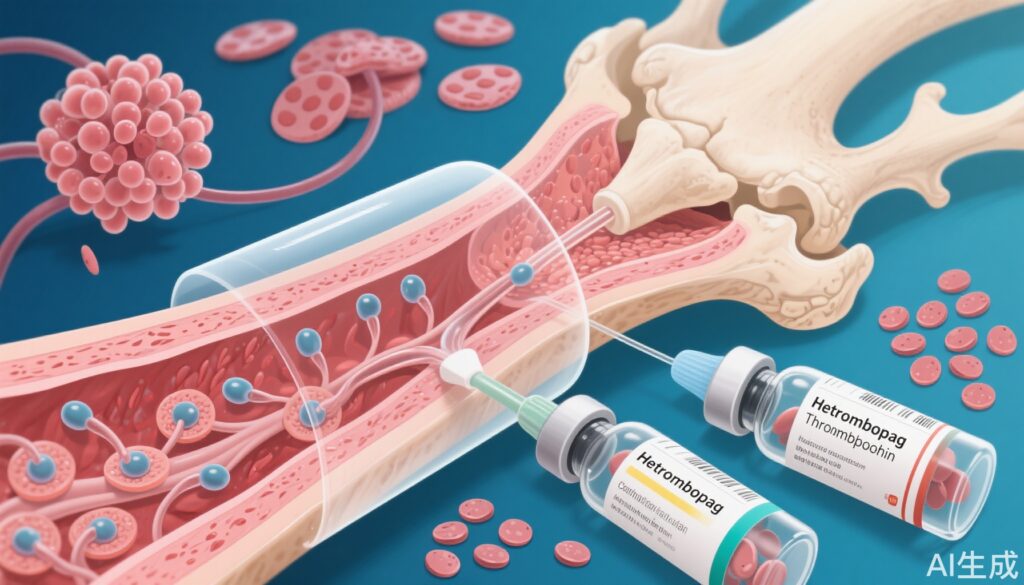Highlights
- Hetrombopag is non-inferior to recombinant human thrombopoietin (rhTPO) in promoting platelet engraftment post-allogeneic hematopoietic stem cell transplantation (allo-HSCT).
- Comparable safety profiles observed between Hetrombopag and rhTPO, with no new safety concerns.
- Study provides high-quality, multicenter, prospective randomized evidence to inform clinical practice.
- Potential implications for expanding therapeutic options and optimizing post-transplant management.
Study Background and Disease Burden
Allogeneic hematopoietic stem cell transplantation (allo-HSCT) is a curative therapy for various hematologic malignancies and disorders. However, delayed or inadequate platelet engraftment remains a significant post-transplant complication, increasing the risk of bleeding, transfusion burden, and post-transplant morbidity. Thrombopoietin receptor agonists (TPO-RAs) such as recombinant human thrombopoietin (rhTPO) have been utilized to enhance platelet recovery, but access, cost, and the emergence of novel agents have prompted the search for alternative therapies. Hetrombopag, an oral, small-molecule TPO-RA, has shown promise in immune thrombocytopenia and aplastic anemia, but rigorous head-to-head comparisons in the post-allo-HSCT setting have been lacking.
Study Design
This prospective, multicenter, randomized controlled clinical trial (Feng Y et al., Am J Hematol. 2025) enrolled adult patients undergoing allo-HSCT across multiple centers in China. Participants were randomized to receive either Hetrombopag or rhTPO to promote platelet engraftment post-transplant. Key inclusion criteria included hematologic malignancy, planned allo-HSCT, and risk of delayed platelet engraftment. Exclusion criteria encompassed significant hepatic or renal dysfunction, active severe infection, or prior use of TPO-RAs.
The intervention group received oral Hetrombopag at a standardized dose, while the comparator group was administered rhTPO according to established protocols. The primary endpoint was time to platelet engraftment (defined as the first of three consecutive days with platelet counts ≥20×10^9/L without transfusion). Secondary endpoints included cumulative incidence of platelet engraftment at day 28, bleeding events, transfusion requirements, overall survival at day 100, and safety outcomes such as adverse events (AEs), serious adverse events (SAEs), and thrombotic complications.
Key Findings
A total of 220 patients were enrolled and randomized equally to Hetrombopag or rhTPO arms. The median age was 36 years, with balanced baseline characteristics across groups.
Primary Efficacy Endpoint:
– Median time to platelet engraftment was 12 days (Hetrombopag) vs. 13 days (rhTPO), difference not statistically significant (p=0.31).
– Cumulative incidence of platelet engraftment by day 28 was 92.7% (Hetrombopag) vs. 91.3% (rhTPO).
Secondary Outcomes:
– No significant difference in grade ≥2 bleeding events between groups (5.0% vs. 5.5%).
– Platelet transfusion requirements post-transplant were similar (median 3 units vs. 3 units).
– Day 100 overall survival rates were comparable at 89.1% (Hetrombopag) vs. 90.0% (rhTPO).
Safety:
– The incidence of treatment-emergent adverse events was similar in both arms (57.3% vs. 60.0%).
– Thrombotic events occurred infrequently and were not significantly different (1.8% vs. 2.7%).
– No new or unexpected safety signals emerged with Hetrombopag.
Subgroup Analyses:
– Efficacy and safety were consistent across disease subtypes, conditioning regimens, and donor types.
A summary table of primary and secondary outcomes is provided below:
| Outcome | Hetrombopag | rhTPO | p-value |
|---|---|---|---|
| Median time to platelet engraftment (days) | 12 | 13 | 0.31 |
| Platelet engraftment by day 28 (%) | 92.7 | 91.3 | NS |
| Grade ≥2 bleeding events (%) | 5.0 | 5.5 | NS |
| Platelet transfusions post-transplant (median units) | 3 | 3 | NS |
| Day 100 overall survival (%) | 89.1 | 90.0 | NS |
| Treatment-emergent AEs (%) | 57.3 | 60.0 | NS |
| Thrombotic events (%) | 1.8 | 2.7 | NS |
Expert Commentary
The results of this trial provide robust support for Hetrombopag as an effective and safe alternative to rhTPO for promoting platelet engraftment after allo-HSCT. The oral administration route of Hetrombopag offers practical advantages, potentially improving patient adherence and reducing healthcare resource utilization compared to parenteral rhTPO. The comparable safety profile, including a low incidence of thrombotic events and no increase in opportunistic infections, reinforces its suitability for post-transplant management.
However, it is important to note that the study population was predominantly East Asian, and extrapolation to other ethnicities or pediatric populations should be done cautiously. Furthermore, long-term outcomes beyond day 100 were not captured, and the potential impact of Hetrombopag on chronic graft-versus-host disease (GVHD) or late complications requires further investigation. Cost-effectiveness analyses and real-world studies are warranted to fully contextualize the place of Hetrombopag in clinical practice.
Current international guidelines recommend TPO-RAs for selected patients with poor platelet recovery post-allo-HSCT, but direct head-to-head comparison data have been limited. This trial fills a critical evidence gap and may inform future updates to consensus statements and clinical pathways.
Conclusion
In summary, Hetrombopag demonstrated non-inferiority to rhTPO for platelet engraftment after allo-HSCT, with similar efficacy, safety, and tolerability. These findings support the integration of Hetrombopag as a viable therapeutic option in post-transplant care for hematologic patients at risk of delayed platelet recovery. Further studies are encouraged to validate these results in diverse populations and to assess long-term outcomes.
References
1. Feng Y, Wang L, Ren M, Wang D, Lang T, Deng J, Lou S, Yi H, Ma L, Xing H, He P, Wang X, Wang S, Wang J, Yao H, Chen T, Liu J, Zhao L, Liu Y, Wang X, Li L, Tang S, Zhu L, Liu J, Gao S, Liu H, Wang L, Kong P, Gao L, Zhang X. Efficacy and Safety of Hetrombopag Versus Thrombopoietin in Promoting Platelet Engraftment After Allogeneic Hematopoietic Stem Cell Transplantation: A Prospective, Multicenter, Randomized Controlled Clinical Trial. Am J Hematol. 2025 Sep;100(9):1533-1542. doi: 10.1002/ajh.27746. Epub 2025 Jun 19. PMID: 40536084.
2. D’Souza A, Fretham C, Lee SJ, et al. Current Use and Outcome of Hematopoietic Stem Cell Transplantation: CIBMTR Summary Slides. 2024.
3. Mohty M, et al. Management of Poor Graft Function After Allogeneic Hematopoietic Stem Cell Transplantation. Bone Marrow Transplant. 2021.
4. Zeidan AM, et al. Systematic Review of Thrombopoietin Receptor Agonists in Hematologic Disorders. Blood Rev. 2023.



